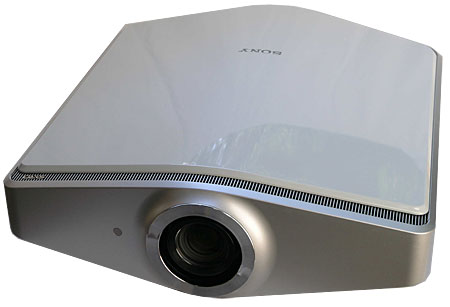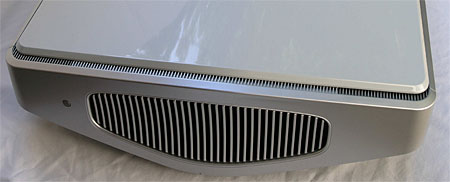Sony VPL-VW100 SXRD Video Projector Part II

The delay also gave me more time with the projector. Further viewing certainly did not change my opinion of this superb product. But it did surface an additional problem with this (admittedly pre-production) sample, allow me to check out the projector with a 1080p input, provided an early comparison with one of the best new single-chip DLP projectors, and generated food for thought about contrast ratios and the arcane subject of gamma.
Turn Me On
I'll touch on the new problem quickly. On several occasions the projector simply would not fully power up. I would hear periodic clicking coming from inside the case; the amber warning light on the projector's top front, under the decorative ribs, would turn on and the lamp would not illuminate. I finally found that I could get around this by sliding the top cover forward or backward slightly (it had about a half inch of play), though a few times it was touch-and-go whether or not the review process would be abruptly ended. I suspect the culprit is an out-of-whack safety switch that prevents the projector from being turned on if the cover is removed. This was also very likely a quirk restricted to the review sample, an early unit with no serial number, only a string of Japanese characters in the spot where such a number would normally be found.
1080p Me
I still don't have a native 1080p source, so how the additional resolution that such a source might provide to further enhance the projector's image remains unexplored. But shortly before I wrapped the review, we received the Marantz DV9600 DVD player for evaluation.
The DV9600 is one of a small group of new DVD players that provides onboard upconversion of DVDs to 1080p/60 from its HDMI output. While this adds no additional detail to a DVD's standard definition image, it does provide a source that the projector treats as 1080p/60 since it has no way of distinguishing it from native 1080p. The Sony locked onto the signal perfectly. When I compared the image from the player in 1080p (with the player doing the upconversion) to the image with the player set to output 480i (with the projector doing all the upconversion to its native 1080p display), there were very subtle differences, mostly in detail, in favor of the 1080p input. But this will certainly vary with the source. The point is that the Sony will lock onto, and display, a 1080p/60 signal. The Sony is also designed to respond directly to a 1080p/24 source as well (the rate that will reportedly be on some Blu-ray discs), though we have, as yet, no way to check this.
Lightening Up
A display's gamma determines how much the light output of a projector changes with each change in the input signal. While gamma exists for each color, when we use the word gamma without qualifying it we normally mean the change in luminance—or the black and white portion of the signal.
A display's gamma curve should remain constant at each point in the brightness range (the theoretical ideal is quantified as being between 2.2 and 2.4). And with the Sony's dynamic iris in the Off (inactive) position, the gamma curve does remain fairly steady at around 2.05. But when I first measured the gamma with the iris in the Auto (dynamic), the results were weird. I soon figured out why. I had used window patterns to measure it, as I did with the iris on Off. While that works with most projectors, the dynamic iris makes those window patterns useless for this measurement. (For why this is so, see "Further Tests and Calibration.") I ultimately obtained good results with the full-field patterns on one of the Avia Pro test DVDs. Apart from a slight darkening at very low brightness levels (about 20IRE) to a gamma just over 2.6, the Sony's gamma in the Auto position of its Advanced Iris, with the Gamma Correction Off, ranged between 2.2 and 2.3 across the full brightness range—closer to the ideal than with the dynamic iris Off.
I occasionally felt that a mid-level or bright scene here or there looked a little lighter than I thought it should be. I generally prefer a gamma closer to 2.4, which often provides a little more punch and saturation. But the Sony's 2.2 gamma image never looked washed out or pale. If the Sony were a speaker, I'd say that it has a somewhat laid-back midrange. The Gamma 3 setting did darken the mid tones slightly, which I preferred on some—but not all—program material.
Comparisons
I've only spent time (just a few hours, so far) with one other projector that will give this one a serious run for its money. At a notably more expensive $12,500 the Yamaha DPX-1300 offers more light output (if you open up its manual iris, and admittedly I'm also viewing the Yamaha with a new lamp), more accurate color points, more adjustability, cheaper replacement lamps, and a somewhat sharper image. Yes, the latter observation sounds odd when you consider that the Yamaha has a lower native resolution (1280x720), but the apparent resolution enhancement might be due less to the Yamaha itself than to its Silicon Optix scaler—the current hot ticket in that department.

On the other hand, while it's hardly noisy, the DPX-1300 is louder than the nearly silent Sony, can't match the latter's blacks (though it's not exactly chopped liver in that department), does flash the occasional rainbow, and doesn't produce quite as silky-smooth an image as the Sony on high definition sources—almost certainly due to the Sony's higher pixel count. (A full review of the DPX-1300 is in the works).
Final Thoughts
While no video display is perfect, the Sony VPL-VW100 can compete with any projector in its price class. It will beat any digital projector I know of in the richness of its blacks, is the least expensive projector offering 1080p resolution (including the ability to accept a native 1080p source directly), and won't be shamed by any of the significantly more expensive projectors I'm familiar with in any way apart from maximum light output.
The Sony is a remarkable value and without question one of the best video projectors on the market. If you are looking in this price range—or even significantly higher—you'd be crazy not to put it at or near the top of a very short shopping list.
Highs and Lows
Highs
Beautifully smooth, detailed image
The best black levels of any digital projector we've yet reviewed
Nearly silent operation
Low
Color points wider than either the ATSC or NTSC standards
- Log in or register to post comments




































































